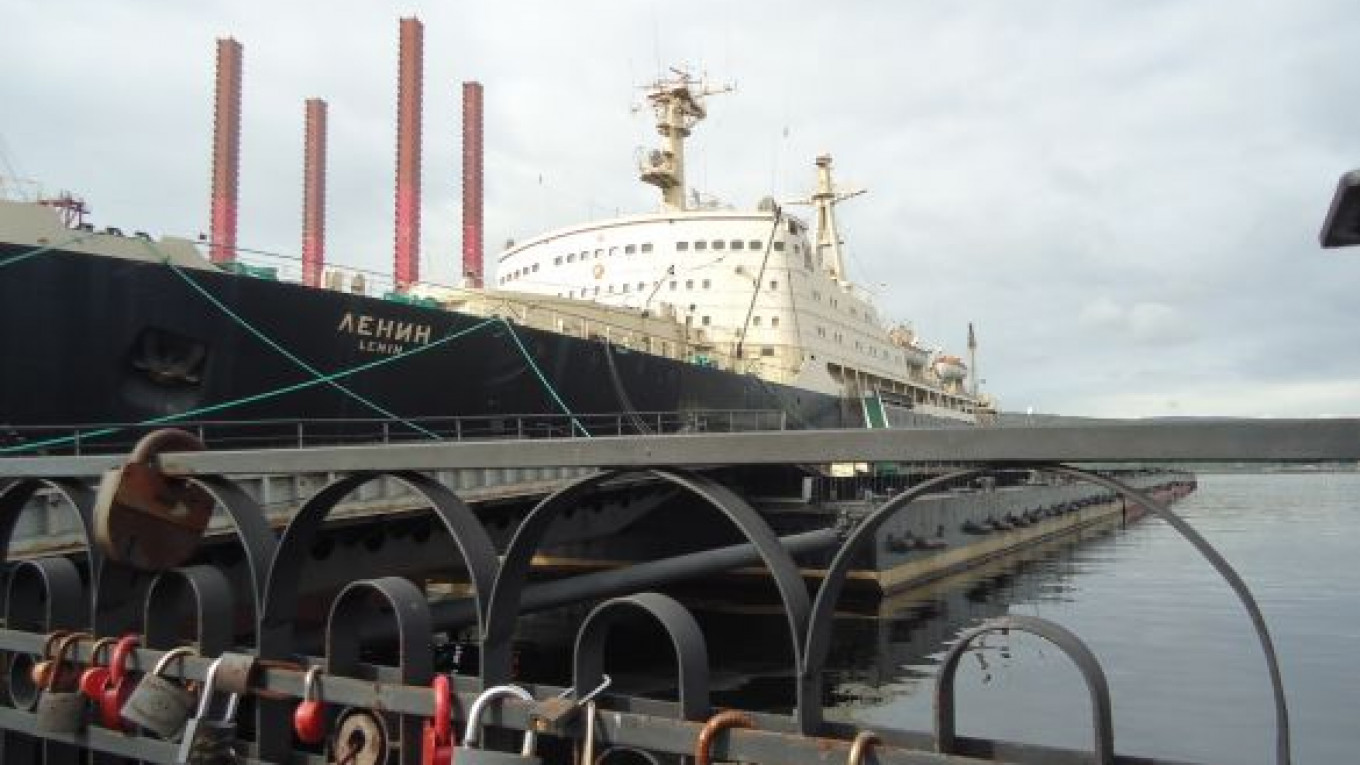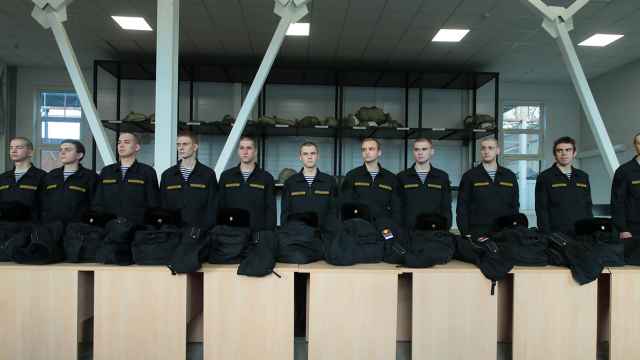MURMANSK — With their strangely elegant keel-less black hulls supporting the bulky but streamlined superstructure, there is something ineffably spine-tingling about standing next to a nuclear-powered icebreaker.
The Lenin, launched in 1959, was the first-ever built and is now permanently moored on Murmansk's seafront. The railing on the dockside is adorned with padlocks and graffiti left by local young couples in love.
These vessels, which were only ever built in the Soviet Union and the stars of hundreds of iconic photographs of Arctic exploration, seem to ooze adventure out of their supposedly radiation-proof hulls and are symbols of the city's former and future potential — which is set to grow dramatically thanks to the race to extract the Arctic's natural resources.
Ships and Sailors
Nuclear icebreakers are part of the fabric of Murmansk. Even the nightclub at the city's Radisson hotel is called Lyodokol, the Icebreaker.
But life on board wasn't always all that great.
"Four hours on, eight hours off, for four months without a break," said Andrei Zolotkov, who served in the icebreaker fleet for many years. "And sometimes they'd vibrate like crazy."
Zolotkov, a Murmansk native, eventually quit – not because of the pay, which he says was double that of the average for other sailors in the Soviet era, or even because of the nuclear safety issue – but because of the climate.
"There were people from all over serving on the icebreakers, Moscow, St. Petersburg, Ukraine. And for them it was great. You did four months at sea in the Arctic and then went home. But I'm from Murmansk. I'd do my four months and then I'd be stuck here where it never gets light in winter."
He is now head of the local chapter of Bellona, an environmental organization that specializes in fighting pollution from nuclear relics of the Cold War.
And he is not especially keen on some of the relics lining the Kola Bay, the long black finger of water reaching inland from the Barents Sea that for nearly a century has served as Russia's northern-most ice-free port.
On the eastern shore of the bay, the city of Murmansk – the largest anywhere in the Arctic Circle – huddles on a series of hills tumbling down to the waterline, where dinosaur-like cranes load mountains of Siberian coal into freighters.
All along the water, oil tankers, container ships and Atomflot's fleet of nuclear-powered icebreakers testify to this remote city's claim to fame as the country's northern gateway.
Atomflot, a subsidiary of state-owned nuclear monopoly Rosatom, has seven nuclear-powered icebreakers currently in operation, the newest being the Fifty Years of Victory, launched in 2007. Two defueled and retired nuclear icebreakers, the Sibir and the Arktika, which in 1975 became the first surface vessel to reach the North Pole, are moored awaiting renovation or decommissioning at Atomflot's base two kilometers north of the city.
Radioactive Soviet relics are a fact of life in Murmansk. In a bay to the west, toward the Norwegian border, more than 40 reactor sections cut from nuclear submarines are in storage. Hopefully, in about 100 years, someone will find a use for those radioactive hunks of metal, Zolotkov said. Until then, they will stay there.
"What if you have a tanker coming down here and it loses steerage power and collides with them?" he asked, gesturing toward the Atomflot fleet moored against green hills. "It's a pretty extreme scenario, but after Fukushima, who knows," he said.
Zolotkov is not opposed to the technology in principle. Icebreakers are actually pretty reliable, he says. There have been only two serious accidents, he said, both aboard the Lenin; neither was fatal, although it later emerged that the waste was dumped in the Arctic sea.
The sailor-turned-activist says he'd rather see Atomflot build its nuclear bases a safe distance from population centers, like the Navy does.
The ability of a nuclear icebreaker to stay at sea almost indefinitely (Soviet-built models needed refueling only once every four to five years, and the new generation under construction at shipyards on the Russian Baltic should be able to last even longer) makes them indispensable to the fulfillment of the country's maritime ambitions.
"If Russia wants to be the master of the Arctic, we need them — you can't do it with anything else," he said.
And mastering the Arctic is exactly Russia's intention: Murmansk is set to be the epicenter of the effort.
Renaissance From Resources
Beginning life as a rail terminus and dock during the First World War, Murmansk became famous in the Second World War as the landing point for lend-lease convoys that brought precious supplies to its ice-free bay from Britain.
In recent years it has fallen on harder times. The subsidies and generous wages and pensions that workers used to get for enduring the long winter nights and short summer dried up at the end of the Soviet Union. The huge cargos carried by Sevrmorput, the state-owned arctic shipping company, from industrial giants like Norilsk and other far northern outposts of the Soviet empire have contracted vastly, Zolotkov said. The harbor is now stacked high with mountains of coal brought by the trainload for export from Siberia — but not much else.
Murmansk is home to 300,000 residents, although 30,000 people have left in the last 10 years. Zolotkov sees the demographic trend as ironic: The Soviets once planned to boost the city's population to 750,000.
But now the city and its bay have become the cockpit for an oil and gas driven dash for the Arctic.
The Shtokman gas field in the Barents Sea is thought to hold 3.8 trillion cubic meters of natural gas. Gazprom says Prirazlomnoye, an oil field on the other side of the Barents just south of Novaya Zemlya, holds 72 million tons of oil reserves.
The tankers, oil platforms, and icebreakers needed to develop these fields will all be based in Murmansk. And along the fjord, the paraphernalia of Russia's march to the north jostles with Soviet history.
Alongside the Admiral Kuznetsov, Russia's only aircraft carrier, four huge metal columns reach for the sky.
They are the legs of the Arkticheskaya, a new drilling platform destined for the vast offshore fields.
Last year, the Prirazlomnoye platform — the first purpose-built platform for the new arctic fields built at the Sevmash military shipyard near Arkhangelsk — was towed out of Kola Bay to begin exploratory drilling in the Pechora Sea, over 805 kilometers away south of Novaya Zemlya.
The oil recovered by these platforms will be loaded onto ice-class tankers and brought back to Kola Bay, where it will be loaded into the Belokamenka storage facility, which is actually a retired Japanese-built super tanker moored like a colossal red brick in the middle of the fjord north of the Atomflot base.
Unable to leave Russian waters because of its single hull — safety standards in most countries now require tankers to be at least double-hulled — the Belokamenka is permanently in Kola Bay and is currently used by LUKoil to store oil from its fields in the Yamal peninsula.
Ocean-going tankers will then pick up oil from the floating depot and take it to refineries in Rotterdam.
That is the plan, and Rosatom has already ordered a new generation of icebreakers from shipyards in St. Petersburg to support it.
Boom Brings Risks
But Russian environmentalists have more than a few problems with how the situation is evolving.
For a start, it is two to three days sailing from Murmansk to Prirazlomnoye. If something goes wrong at the gas field, the platform's crew will have an agonizing wait for the support vessels docked along Kola Bay to come to the rescue.
They also say the platform will need to be constantly attended to by at least one icebreaker to keep the sea around it clear in winter.
Then there is the business of loading and unloading oil. This is the riskiest part of the transportation process — first in the rolling seas of the open Arctic Ocean, and again in the Kola Bay, said Roman Dolgov, director of Greenpeace Russia's arctic program.
That's why this past weekend, just behind the Belokamenka, a comparatively tiny white and green vessel was anchored.
The Arctic Sunrise, a 49-meter conventionally fuelled icebreaker owned by Greenpeace International, departed Monday evening on a tour of the Barents Sea gas fields.
The environmental group wants to highlight what it calls unacceptable risks in developing offshore fields in the Arctic by giving journalists a chance to "experience [the] severe weather conditions that greatly raise the risk of an oil spill in the area."
The idea, says Greenpeace Russia's Vladimir Chuprov, is to challenge what he calls a "strategic error" of opening up the Arctic to oil and gas development.
"You only need Arctic development if you have decided that Russia's economy will continue to be reliant on oil and gas. Either we concentrate on modernizing the country and switching to a high-tech economy, or we put those massive resources into opening the Arctic and continue to live on oil. We can't do both. Unfortunately, [President Vladimir] Putin seems to have made his choice," Chuprov said.
Exactly how to halt the development is difficult to see, though Dolgov says they have done it before.
"In the 1990s we were campaigning for a ban on underground nuclear testing, and in 1996 we got the comprehensive test ban treaty. I think Greenpeace made a big contribution to that. So the ultimate goal is to get an international agreement like we have for Antarctica, banning exploitation of the Arctic so its unique ecosystem is preserved," he said.
Locals in Murmansk's central square, where Greenpeace was gathering signatures of support on Sunday, were generally positive about the activists' mission. "It's extremely important. We always want to preserve the Arctic and the environment for our children," said Victor Smirnov, a railway worker.
But Dolgov acknowledged that some had questioned how Russia would be able to pay for social programs, hospitals and schools without the more than 50 percent of the budget contributed by oil and gas money.
In Murmansk, where, together with the opening of a new sea-route from Europe to the Far East, the project offers hope of jobs, money and the economic rebirth of the kind Scotland's Aberdeen has thrived on since the discovery of North Sea oil, the force of the economic argument has obvious appeal. But it comes tinged with skepticism born of disappointment.
"There's always a lot of potential here. But that's the thing with potential: It is always in the future," Zolotkov said, casting a critical eye over the icebreakers, oil tankers and semi-complete oil platforms moored on the bay's cold, dark waters.
"They've been talking about Shtokman for 50 or 60 years. We still haven't seen anything yet," he added.
A Message from The Moscow Times:
Dear readers,
We are facing unprecedented challenges. Russia's Prosecutor General's Office has designated The Moscow Times as an "undesirable" organization, criminalizing our work and putting our staff at risk of prosecution. This follows our earlier unjust labeling as a "foreign agent."
These actions are direct attempts to silence independent journalism in Russia. The authorities claim our work "discredits the decisions of the Russian leadership." We see things differently: we strive to provide accurate, unbiased reporting on Russia.
We, the journalists of The Moscow Times, refuse to be silenced. But to continue our work, we need your help.
Your support, no matter how small, makes a world of difference. If you can, please support us monthly starting from just $2. It's quick to set up, and every contribution makes a significant impact.
By supporting The Moscow Times, you're defending open, independent journalism in the face of repression. Thank you for standing with us.
Remind me later.






